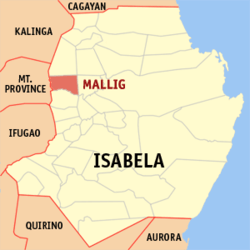Mallig, Isabela
Mallig, officially the Municipality of Mallig (Ilocano: Ili ti Mallig; Tagalog: Bayan ng Mallig), is a 4th class municipality in the province of Isabela, Philippines. According to the 2015 census, it has a population of 30,459 people.[3]
Mallig | |
|---|---|
| Municipality of Mallig | |
 Mallig Town Proper | |
 Seal | |
 Map of Isabela with Mallig highlighted | |
OpenStreetMap 
| |
.svg.png) Mallig Location within the Philippines | |
| Coordinates: 17°12′N 121°37′E | |
| Country | |
| Region | Cagayan Valley (Region II) |
| Province | Isabela |
| District | 5th District of Isabela |
| Founded | April 8, 1953 |
| Barangays | 18 (see Barangays) |
| Government | |
| • Type | Sangguniang Bayan |
| • Mayor | Jose P. Calderon |
| • Vice Mayor | Diosdado B. Felipe |
| • Congressman | Faustino Michael Carlos T. Dy III |
| • Electorate | 19,782 voters (2019) |
| Area | |
| • Total | 133.40 km2 (51.51 sq mi) |
| Population (2015 census)[3] | |
| • Total | 30,459 |
| • Density | 230/km2 (590/sq mi) |
| • Households | 7,588 |
| Economy | |
| • Income class | 4th municipal income class |
| • Poverty incidence | 13.29% (2015)[4] |
| • Revenue (₱) | 86,386,943.44 (2016) |
| Time zone | UTC+8 (PST) |
| ZIP code | 3323 |
| PSGC | |
| IDD : area code | +63 (0)78 |
| Climate type | tropical rainforest climate |
| Native languages | Ibanag Ilocano Tagalog |
| Website | www |
History
The municipality of Mallig was named after the Mallig river that traverses it. The area was first mentioned by Fray Pedro de Santo Tomas as the area to which the Irray/Gaddang fled after the revolt of Dayag and Catabay in 1621 in what is now Ilagan City.
In 1939, then President Manuel L. Quezon declared the westernmost part of the province as a resettlement area, historically known as the Mallig Plains Resettlement Area. From then on, the influx of settlers from the Central Plains and the Ilocos Region encouraged more other settlers to migrate westward in these Kalinga-dominated plains.
Mallig was created by virtue of RA 678 authored in 1952 by congressman Samuel F. Reyes. The act was approved on April 8, 1953 with the former barrio Olango as the seat of government. The territory comprising Mallig was taken from several neighboring towns:
- from Roxas: barrios of Holy Friday, San Jose (East), and San Jose (West)
- from Ilagan City: barrios of Casili, Olango Primero, Olango Segundo, San Jose Nuevo, and Manano
- from Tumauini: barrios of Barucbuc, Siempre Viva, Bimmonton, Pasurgong, Manga, and Settlement No. 1
- from Santo Tomas: barrios of Abut and Minagbag[5]
Mallig was never a ready haven and abode for the migrants at the beginning, particularly because of the hostile natives who formerly dominated the area, and also because of the occurrence of endemic malaria. It took the settlers gradual adaptation and acclimatization before they finally convinced their relatives and other migrants to settle permanently.[6]
Geography
Mallig is bounded by the towns of Paracelis, Mt. Province on its western limits, Quezon, Isabela on its northern limits, Roxas, Isabela on its southern limits and by both Delfin Albano and Quirino, Isabela on its eastern limits. It is municipality within the Division/Province of Isabela in the region of Cagayan Valley.
Its main gateway is the Santiago-Tuguegarao road which is a part of the national highway. The Ilagan-Delfin Albano-Mallig road, a provincial road, also serves as an important point of entry to Mallig.
It is also an agricultural town mainly composed of agricultural farms such as rice fields and corn fields which makes its rural landscape.
Barangays
Mallig is politically subdivided into 18 barangays. [2]
- San Pedro (Barucbuc Sur)
- Bimonton
- Casili
- Centro I
- Holy Friday
- Jacinto Baniqued (Centro II pob)
- Maligaya
- Manano
- Olango
- Rang-ayan
- San Jose Norte I
- San Jose Sur
- Siempre Viva Norte
- Trinidad
- Victoria
- San Jose Norte II
- San Ramon
- Siempre Viva Sur
Climate
The climate in Mallig is tropical. Mallig has significant rainfall most months, with a short dry season. This location is classified as Am by Köppen and Geiger. The temperature here averages 27.0 °C. The average annual rainfall is 1784 mm.
| Climate data for Mallig, Isabela | |||||||||||||
|---|---|---|---|---|---|---|---|---|---|---|---|---|---|
| Month | Jan | Feb | Mar | Apr | May | Jun | Jul | Aug | Sep | Oct | Nov | Dec | Year |
| Average high °C (°F) | 29 (84) |
30 (86) |
32 (90) |
35 (95) |
35 (95) |
35 (95) |
34 (93) |
33 (91) |
32 (90) |
31 (88) |
30 (86) |
28 (82) |
32 (90) |
| Average low °C (°F) | 19 (66) |
20 (68) |
21 (70) |
23 (73) |
23 (73) |
24 (75) |
23 (73) |
23 (73) |
23 (73) |
22 (72) |
21 (70) |
20 (68) |
22 (71) |
| Average precipitation mm (inches) | 31.2 (1.23) |
23 (0.9) |
27.7 (1.09) |
28.1 (1.11) |
113.5 (4.47) |
141.4 (5.57) |
176.4 (6.94) |
236.6 (9.31) |
224.9 (8.85) |
247.7 (9.75) |
222.9 (8.78) |
178 (7.0) |
1,651.4 (65) |
| Average rainy days | 10 | 6 | 5 | 5 | 13 | 12 | 15 | 15 | 15 | 17 | 16 | 15 | 144 |
| Source: World Weather Online[7] | |||||||||||||
Demographics
|
| |||||||||||||||||||||||||||||||||
| Source: Philippine Statistics Authority[3][8][9][10] | ||||||||||||||||||||||||||||||||||
In the 2015 census, the population of Mallig, Isabela, was 30,459 people,[3] with a density of 230 inhabitants per square kilometre or 600 inhabitants per square mile.
References
- "Municipality". Quezon City, Philippines: Department of the Interior and Local Government. Retrieved 31 May 2013.
- "Province: Isabela". PSGC Interactive. Quezon City, Philippines: Philippine Statistics Authority. Retrieved 12 November 2016.
- Census of Population (2015). "Region II (Cagayan Valley)". Total Population by Province, City, Municipality and Barangay. PSA. Retrieved 20 June 2016.
- "PSA releases the 2015 Municipal and City Level Poverty Estimates". Quezon City, Philippines. Retrieved 1 January 2020.
- "An Act Creating the Municipality of Mallig in the Province of Isabela". LawPH.com. Retrieved 2011-04-09.
- "Mallig, History". malligisabela.com/. malligisabela.com. Retrieved 1 April 2015.
- "Mallig, Isabela: Average Temperatures and Rainfall". World Weather Online. Retrieved 31 October 2015.
- Census of Population and Housing (2010). "Region II (Cagayan Valley)". Total Population by Province, City, Municipality and Barangay. NSO. Retrieved 29 June 2016.
- Censuses of Population (1903–2007). "Region II (Cagayan Valley)". Table 1. Population Enumerated in Various Censuses by Province/Highly Urbanized City: 1903 to 2007. NSO.
- "Province of Isabela". Municipality Population Data. Local Water Utilities Administration Research Division. Retrieved 17 December 2016.